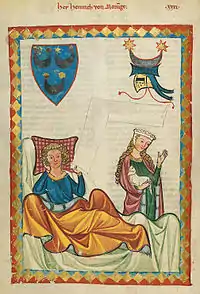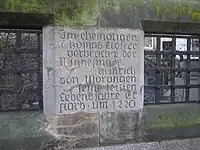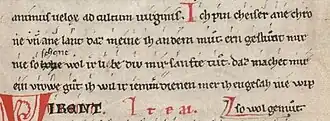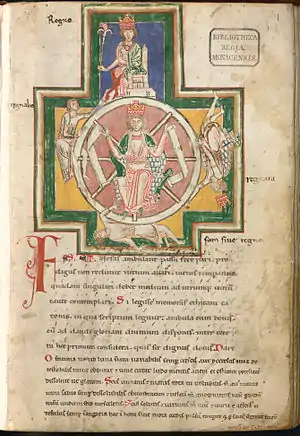
Heinrich von Morungen (died 1222)[1] was a Minnesinger, whose 35 surviving Middle High German songs are dated on both literary and biographical grounds to around the period 1190–1200.[2] Alongside Walter von der Vogelweide and Reinmar he is regarded as one of the most important Minnesänger:[3] he was "the most colourful, passionate, tender and musical of the Minnesänger"[4] and his work "marks a new and brilliantly effective stage in the development of the German lyric."[5]
Life

Morungen is identified with the Hendricus de Morungen who is mentioned in two charters of Dietrich I, Margrave of Meissen. This Hendricus presumably originated from the castle of Morungen near Sangerhausen in Saxony-Anhalt, a location consistent with the language of the songs.[2][6] As a "retired knight" (miles emeritus) he received from his patron Dietrich, also a patron of Walter von der Vogelweide,[7] a pension for his "high personal merits" (alta suae vitae merita). In 1213 he transferred this to the monastery of St Thomas in Leipzig, which he entered himself in 1217. According to a 16th century source based on the records of the monastery, he died there in 1222.[2] The same source reports a certainly apocryphal story of a visit to India.[7][8]
In the Late Middle Ages, there was extant a ballad of Der edele Möringer ("The Noble Moringer"), which transferred to Heinrich von Morungen the stock theme of the return of a husband believed lost.[8]
Works
Manuscript tradition
The manuscript tradition preserves 115 strophes of Morungen's, constituting 35 songs. He is represented in the three main Minnesang manuscripts:.[8][9]
- MS A (the Kleine Heidelberger Liederhandschrift, 1270-1280) has 29 strophes under Morungen's name, though three of these are ascribed to Ulrich von Singenberg in MS C.
- MS B (the Weingarten Manuscript, first quarter of the 14th Century) has 25 strophes under Morungen's name and three under Dietmar von Aist's.
- MS C (the Große Heidelberger Liederhandschrift, the Manesse Codex, c. 1304) has by far the largest collection, with 104 strophes under Morungen's name. Of these 43 appear in the "Tross Fragment" (MS Ca), which is based on C.
Four other manuscripts have small amounts of additional material:

- MS E (the Würzburg Manuscript (München, Universitätsbibliothek, 2° Cod. Ms. 731c., the Housebook of Michael de Leone, 1345-1354) has eight strophes (two songs) of Morungen's under the names of Walther von der Vogelweide and Reinmar.
- MS M (the Carmina Burana MS, Munich, Staatsbibliothek, clm 4660) has a single anonymous strophe matching one in C. It is the only Morungen text with neumes.[3]
- MS p (Berne, Burgerbibliothek, Cod. 260) has four strophes of Morungen's.[10]
- MS S (the Kremsmünster fragment, CC248) has three strophes of the song "Sîn hiez mir nie widersagen" (MF 130,9), including one strophe not in any other MS. At the end of this song on folio 78r of MS C a space large enough for a single strophe has been left, which may have been intended for the additional strophe.[11]
Themes
An essential theme in Morungen's work is the demonic nature of Minne, the Middle High German word for this type of love, which for the mediaeval writers was embodied by the ancient classical goddess of love, Venus. Minne is experienced partly as a magical, pathological, even fatal power, but also as a religious and mystical experience.
Morungen is a very graphic lyricist: he particularly often makes use of images of shining (sun, moon, evening star, gold, jewels, mirror) as comparisons by which to describe the lady who is being sung and praised.
In form and content the poems are influenced by the Provençal troubadour lyric: dactylic rhythms and through-rhymes (Durchreimung) occur frequently. Motifs in the content have also been taken over from the same source: for example, the motif, otherwise rare in German Minnesang, of the "notice of termination of the service of love" (Lied XXVII), the roots of which are to be found in classical literature (for example Ovid).
Legacy
Although Morungen is explicitly named in the works of later poets more rarely than Walther or Reinmar, his surviving corpus of 35 songs is larger than that of any contemporary Minnesänger other than these two, and his influence on the Minnesang tradition was considerable.[12][3]
The Songs
| Song I[lower-alpha 1] | Si ist ze allen êren | MF 122,1[lower-alpha 2] |
| Song II | Mîn liebeste und ouch mîn êrste | MF 123,10 |
| Song III | Het ich tugende niht sô vil | MF 124,32 |
| Song IV | In sô hôher swebender wunne | MF 125,19 |
| Song V | Von den elben | MF 126,8 |
| Song VI a | West ich, ob ez verswîget möhte sîn | MF 127,1 |
| Song VI b | Der alsô vil geriefe | MF 127,12 |
| Song VII | Ez ist site der nahtegal | MF 127,34 |
| Song VIII | Sach ieman die vrouwen | MF 129,14 |
| Song IX | Sîn hiez mir nie widersagen | MF 130,9 |
| Song X | Ich hân sî vür alliu wîp | MF 130,21 |
| Song XI a | Ich bin iemer ander und niht eine | MF 131,25 |
| Song XI b | Ich bin iemer ander, niht der eine | MF 131,25 |
| Song XII | Ist ir liep mîn leit und mîn ungemach | MF 132,27 |
| Song XIII | Leitlîche blicke | MF 133,17 |
| Song XIV | Mîn herze, ir schoene und diu minne | MF 134,6 |
| Song XV | Ez tuot vil wê | MF 134,14 |
| Song XVI | Wê, wie lange sol ich ringen | MF 135,9 |
| Song XVII | Owê, war umbe volg ich tumbem wâne | MF 136,1 |
| Song XVIII | Diu vil guote | MF 136,25 |
| Song XIX | Vrowe, wilt du mich genern | MF 137,10 |
| Song XX | Vrowe, mîne swaere sich | MF 137,17 |
| Song XXI | Ob ich dir vor allen wîben | MF 137,37 |
| Song XXII | Ich waene, nieman lebe | MF 138,17 |
| Song XXIII | Ich hôrte ûf der heide | MF 139,19 |
| Song XXIV | Solde ich iemer vrowen leit | MF 140,11 |
| Song XXV | Uns ist zergangen | MF 140,32 |
| Song XXVI | Mich wundert harte | MF 141,15 |
| Song XXVII | Si hât mich verwunt | MF 141,37 |
| Song XXVIII | Ich bin keiser âne krône | MF 142,19 |
| Song XXIX | Wie sol vröidelôser tage | MF 143,4 |
| Song XXX | Owê, sol aber mir iemer mê | MF 143,22 |
| Song XXXI | Hât man mich gesehen in sorgen | MF 144,17 |
| Song XXXII | Mir ist geschehen als einem kindelîne | MF 145,1 |
| Song XXXIII1 | Ich wil ein reise | MF 145,35 |
| Song XXXIII2 | Ich wil immer singen | MF 146,11 |
| Song XXXIV | Vil süeziu senftiu toeterinne | MF 147,4 |
| Song XXXV | Lange bin ich geweset verdâht | MF 147,17 |
Notes
Editions
- Moser, Hugo; Tervooren, Helmut, eds. (1988). "XIX: Heinrich von Morungen". Des Minnesangs Frühling. Vol. I: Texts (38 ed.). Stuttgart: Hirzel. pp. 236–282. ISBN 978-3777604480.
- Tervooren, Helmut (2003). Heinrich von Morungen. Lieder (3rd ed.). Stuttgart: Reclam. ISBN 3-15-009797-5. With commentary and Modern German translation.
Translations
- Goldin, Frederick (1973). "Heinrich von Morungen". German and Italian lyrics of the Middle Ages: an anthology and a history. Garden City, NY: Anchor. pp. 34–57. ISBN 9780385046176. Retrieved 18 March 2023. Text of eight songs with parallel English translation.
Notes
- ↑ Tervooren 1989, cols. 804–805.
- 1 2 3 Kesting 1969.
- 1 2 3 Kellner 2021, p. 666.
- ↑ Wapnewski 1975, p. 65:"der farbigste, leidenschaftlichste, zǎrteste und musikalischste unter den Minnesängern".
- ↑ Gibbs & Johnson 2002, p. 254.
- ↑ Tervooren 1989, col. 804.
- 1 2 Sayce 1982, p. 166.
- 1 2 3 Tervooren 1989, col. 805.
- ↑ Kellner 2021, p. 665.
- ↑ Tervooren 1989, col. 806.
- ↑ Edwards 1989, pp. 17–18.
- ↑ Johnson 1999, p. 157.
References
- Edwards, Cyril (1989). "The Growth Of A Song: Heinrich Von Morungen's 'Robber Lady' (MF130, 9)". Medium Ævum. 58 (1): 17–33. doi:10.2307/43632509. JSTOR 43632509. Retrieved 16 October 2023.
- Gibbs, Marion; Johnson, Sidney (2002). Medieval German Literature: A Companion. New York, London: Routledge. pp. 252–257. ISBN 0-203-90660-8.
- Johnson, L Peter (1999). Die höfische Literatur der Blütezeit (1160/70-1220/30). Geschichte der deutschen Literatur von den Anfängen bis zum Beginn der Neuzeit. Vol. II, Teil 1. Tübingen: Niemeyer. pp. 157–166. ISBN 978-3-484-10703-8.
- Kellner, Beate (2021). "Heinrich von Morungen". In Kellner, Beate; Reichlin, Susanne; Rudolph, Alexander (eds.). Handbuch Minnesang (PDF). Berlin, Boston: De Gruyter. pp. 665–677. doi:10.1515/9783110351859. ISBN 978-3-11-035181-1. S2CID 243658982.
- Kern, Manfred; Edwards, Cyril; Huber, Christoph, eds. (2015). Das "Narzisslied" Heinrichs von Morungen. Zur mittelalterlichen Liebeslyrik und ihrer philologischen Erschließung. Heidelberg: Universitätsverlag Winter. ISBN 978-3-8253-7531-7.
- Kesting, Peter (1969), "Heinrich von Morungen", Neue Deutsche Biographie (in German), vol. 8, Berlin: Duncker & Humblot, pp. 416–417; (full text online)
- Sayce, Olive (1982). "Heinrich von Morungen". The medieval German lyric, 1150-1300: the development of its themes and forms in their European context. Oxford: Oxford University Press. pp. 166–180. ISBN 0-19-815772-X.
- Tervooren, Helmut (1989). "Heinrich von Morungen". In Ruh, Kurt; Keil, Gundolf; Schröder, Werner (eds.). Die deutsche Literatur des Mittelalters. Verfasserlexikon. Vol. 3. Berlin, New York: Walter De Gruyter. Cols 804–815. ISBN 978-3-11-022248-7.
- Wapnewski, Peter (1975). Waz ist minne: Studien zur mittelhochdeutschen Lyrik. Munich: Beck. ISBN 3406058655.
Further reading
- Fisher, Rodney W. (1996). The Minnesinger Heinrich von Morungen. An Introduction to His Songs. San Francisco: International Scholars Publications. ISBN 1573091162.
External links
- Heinrich von Morungen: Lieder at the Wayback Machine (archived 2011-05-14) — Texts of all the songs, taken from the 38th edition of Des Minnesangs Frühling.
- Heinrich von Morungen in the German National Library catalogue
- Works by or about Heinrich von Morungen at Internet Archive
- Works by Heinrich von Morungen at LibriVox (public domain audiobooks)

- "Nein, ja!" (Salzburger Ensemble for Ancient Music, Dulamans Vröudenton)
- Texts by H. von Morungen set in Art Songs and Choral Works
Facsimiles
- Digital facsimiles of Heinrich von Morungen's lyrics in the
- Kleine Heidelberger Liederhandschrift (A) (University Library, Heidelberg)
- Weingarten Manuscript (B) (Württembergischen Landesbibliothek, Stuttgart)
- Manesse Codex (C) (University Library, Heidelberg)
